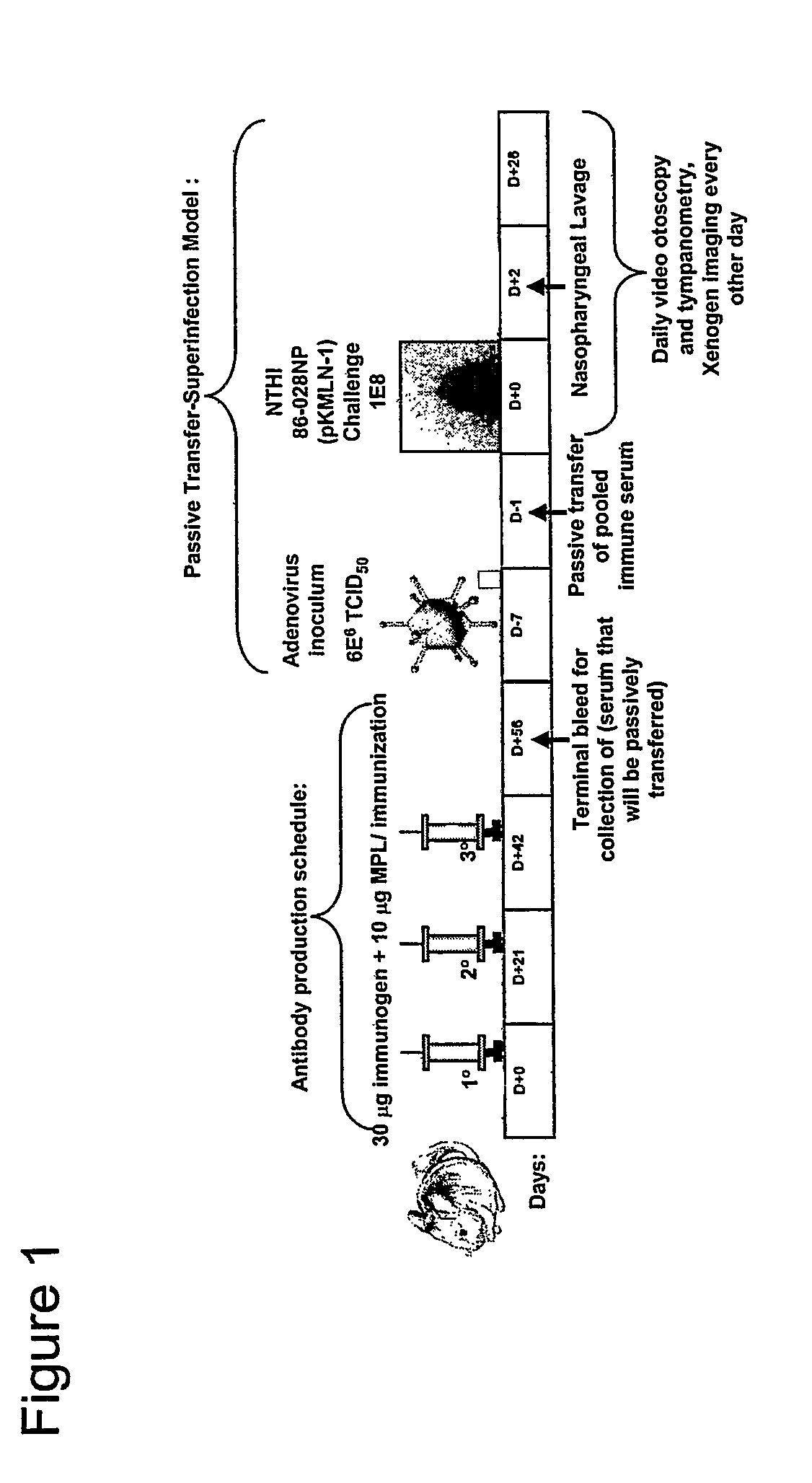Chimeric vaccine for haemophilus influenzae-induced disease
a technology of chimeric vaccine and haemophilus influenzae, which is applied in the field of chimeric protein, can solve the problems of inconvenient and time-consuming purification of fimbrin expressed by the fimbrin gene in other host vectors, tedious and time-consuming methods to isolate fimbrin protein from the outer membrane of bacteria, and achieves more specific vaccine candidates, more effective, and protein folding and/or antigen presentation.
- Summary
- Abstract
- Description
- Claims
- Application Information
AI Technical Summary
Benefits of technology
Problems solved by technology
Method used
Image
Examples
example 1
Synthesis of Chimeric Proteins
[0067]The chimeric proteins of the invention were produced using standard recombinant methods. Initially, a gene-synthesis company, (Blue Heron Biotechnology Inc.) was contracted to make the initial plasmid based on the chimeric protein amino acid sequences described herein that were optimized for E. coli preferred codon usage. Briefly, the native NTHi pilin protein sequence was modified by truncating the N-terminus (residues 1-39 of SEQ ID NO: 2) and adding a HIS-tag sequence and a thrombin cleavage site as set out in SEQ ID NO: 3. The HIS-tag was preceded by a sequence (MGSS) to assist in expression. The thrombin cleavage site allowed for release of the HIS-tag. These plasmids were then cloned into the E. coli expression vector pET-15b vector (Novagen). The plasmid were then transformed into E. coli strain “Origami(DE3)” (available from Novagen) as the host for expression of soluble His-tagged chimeric proteins. Another E. coli host cell expression st...
example 2
Immunogenicity of Chimeric Proteins
[0073]Rabbits or chinchillas are immunized with the chimeric proteins. Rabbits receive an initial immunizing dose of 500 μg of a chimeric protein in complete Freund's adjuvant. The rabbits receive a second dose of 400 μg of the chimeric protein 21 days later. The rabbits receive a third dose of chimeric protein in complete Freund's adjuvant 42 days after the initial immunizing dose with 400 μg of the same peptide in either IFA or PBS (one rabbit per diluent). Sera are obtained 3 weeks after each dose. Chinchillas receive an initial immunizing dose of 10 μg of the chimeric protein in the adjuvant monophosphoryl lipid A (MPL). One month (˜30 days) later, chinchillas receive a second identical dose. The third and final dose is delivered ˜30 days after the second dose. Sera are obtained ˜10-14 days after each dose. The sera from all animals are assessed for titer and specificity against the LB1 peptide (40-mer), LB1(1), PilA protein and the chimeric pr...
example 3
Evaluating Passive Immunization
[0074]The protection conferred by an animal's immune response directed against the chimeric proteins of the invention is determined in a chinchilla model of experimental otitis media. Chinchillas are passively immunized with 5 ml / kg hyperimmune chinchilla or human serum directed against a chimeric protein of the invention. Control chinchillas receive normal chinchilla serum or normal human serum. Next the chinchillas receive first a viral co-pathogen intranasally, then a week later, an intranasal challenge with the NTHi bacteria. The chinchillas are examined and rated daily or every 2 days for up to 35 days after bacterial challenge. Immunized chinchillas receiving immune chinchilla or human serum display reduced tympanic membrane pathology and reduced or absent signs of infection of the middle ear space as determined by both video otoscopy and tympanometry. In this assay, the presence of middle ear fluids in chinchillas receiving chinchilla or human a...
PUM
| Property | Measurement | Unit |
|---|---|---|
| diameter | aaaaa | aaaaa |
| length | aaaaa | aaaaa |
| hydrophobic | aaaaa | aaaaa |
Abstract
Description
Claims
Application Information
 Login to View More
Login to View More - R&D
- Intellectual Property
- Life Sciences
- Materials
- Tech Scout
- Unparalleled Data Quality
- Higher Quality Content
- 60% Fewer Hallucinations
Browse by: Latest US Patents, China's latest patents, Technical Efficacy Thesaurus, Application Domain, Technology Topic, Popular Technical Reports.
© 2025 PatSnap. All rights reserved.Legal|Privacy policy|Modern Slavery Act Transparency Statement|Sitemap|About US| Contact US: help@patsnap.com

